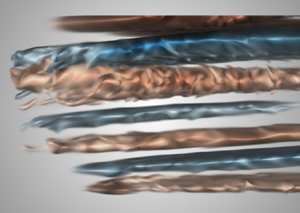Published online by Cambridge University Press: 21 September 2021

In this work we show that horizontal gradients of temperature and salinity with compensating effects on density can drive thermohaline intrusion in the fluid layer below. Specifically, different types of double diffusive convection generate differential vertical fluxes from the top boundary, which then sustain horizontal temperature and salinity gradients within the bulk. Interleaving layers develop in the bulk and slope downward towards the cold fresh side, which are of the diffusive type. New layers emerge near the bottom boundary and shift the existing layers upward due to the density difference induced by the divergence of the vertical fluxes through the top surface. Detailed analyses reveal that the present intrusion is consistent with those in the narrow fronts, and both layer thickness and current velocity follow the corresponding scaling laws. Such intrusion process provides an extra path to transfer heat and salinity horizontally towards the cold and fresh side, but transfer the density anomaly towards the warm and salty side. These findings extend the circumstances where thermohaline intrusions may be observed.